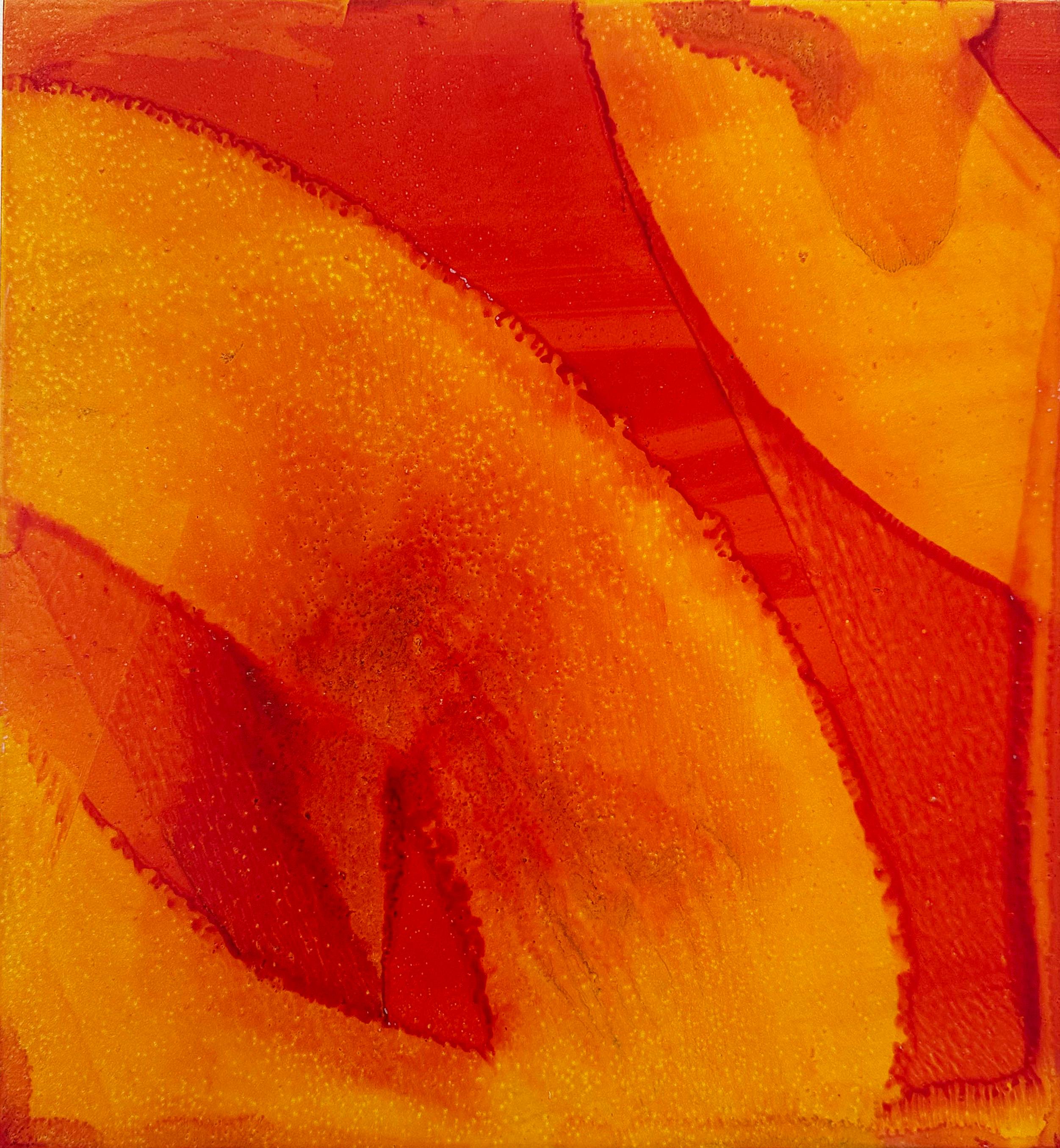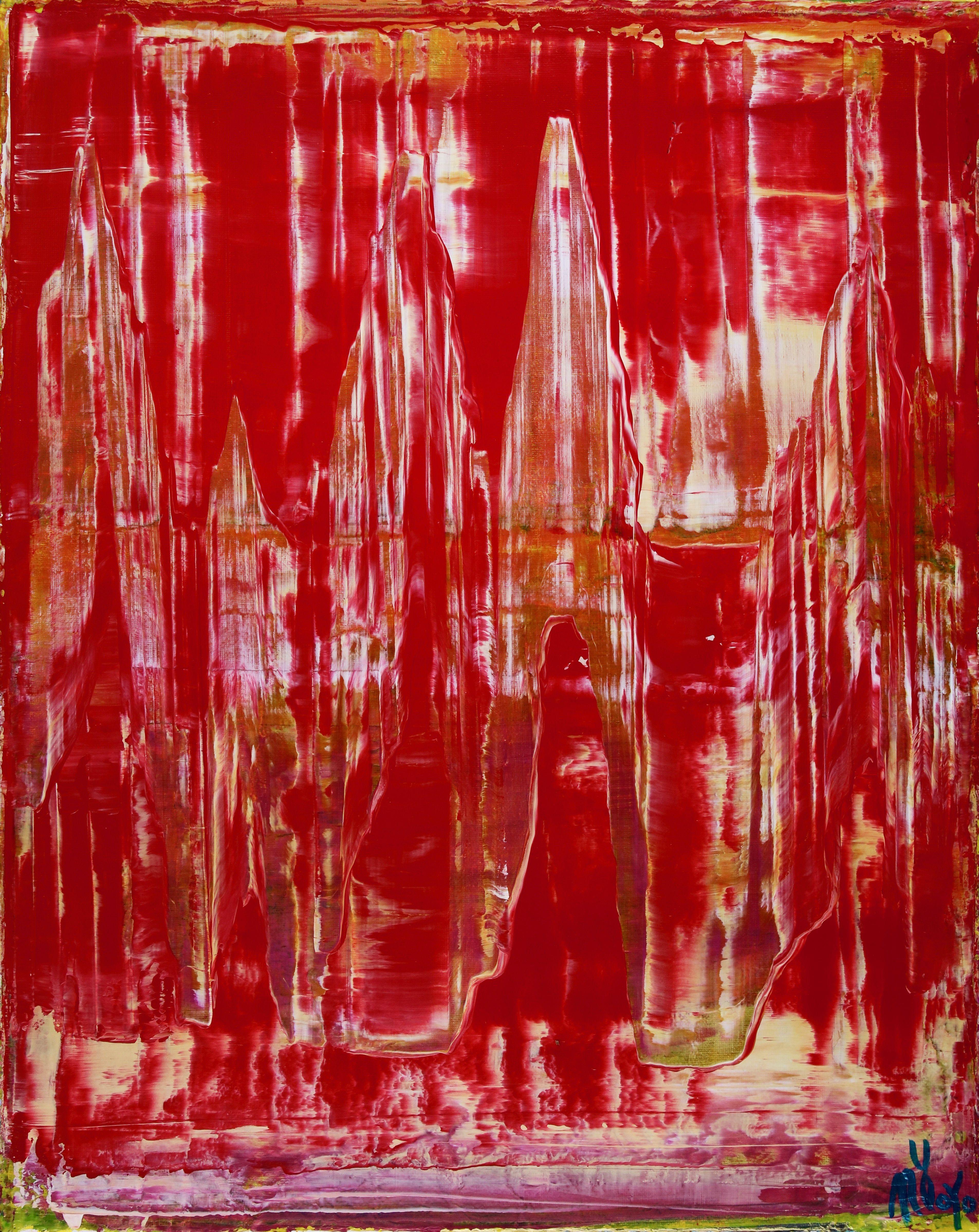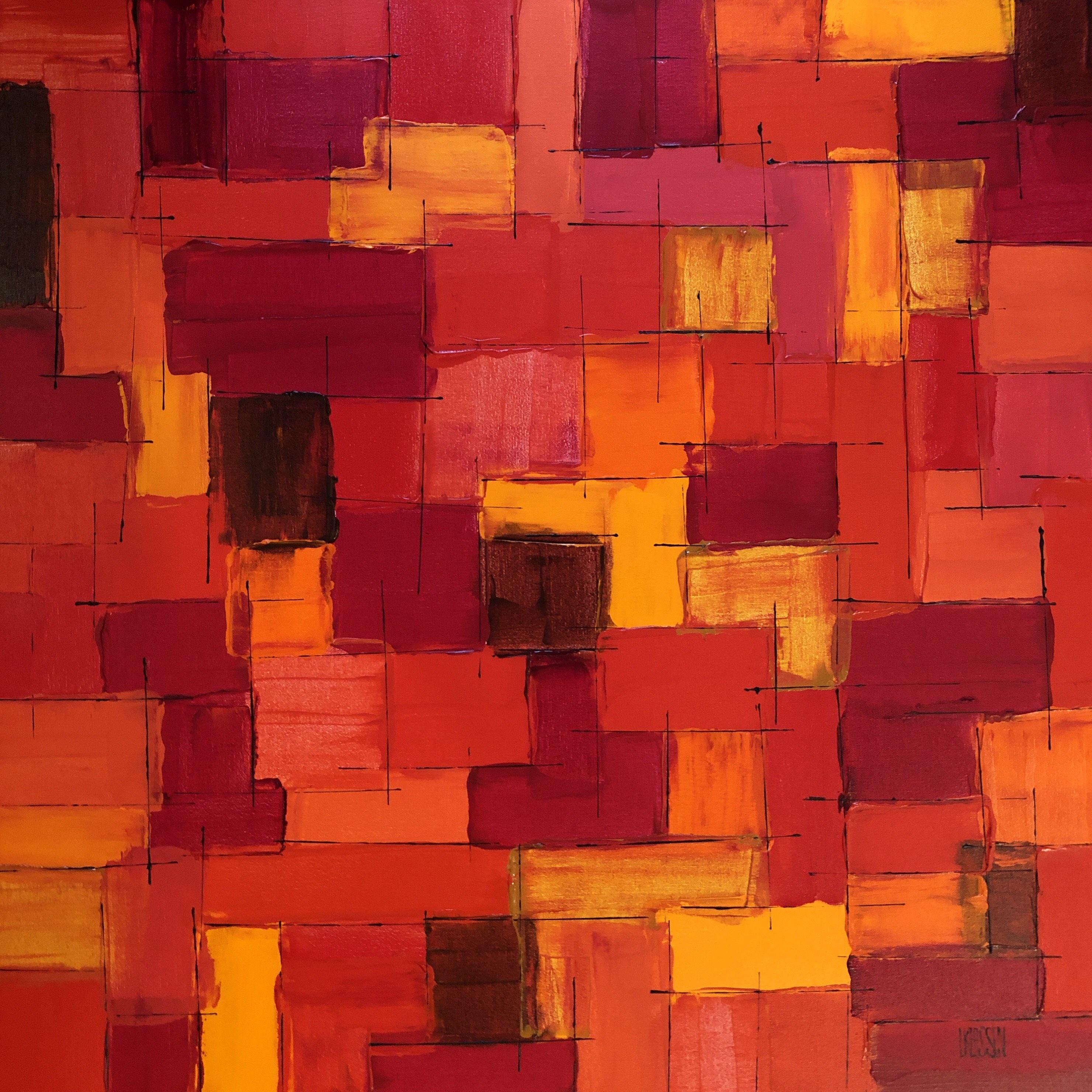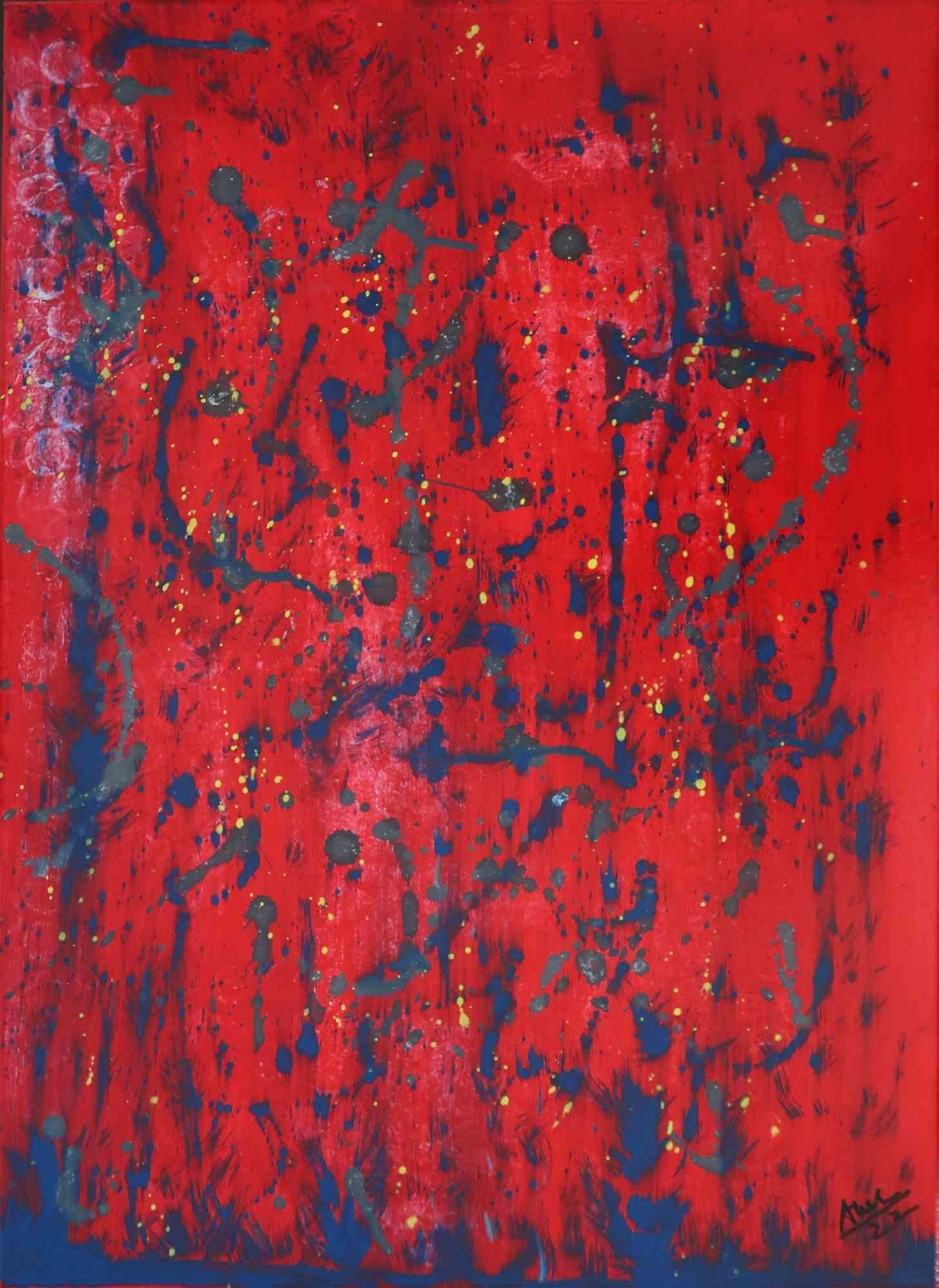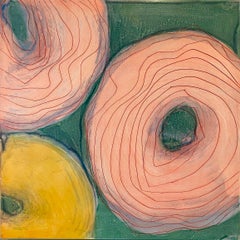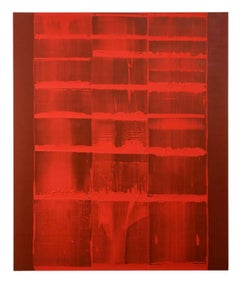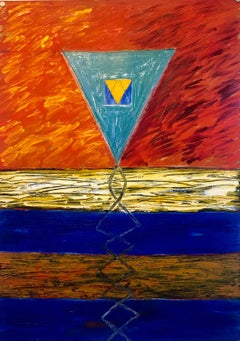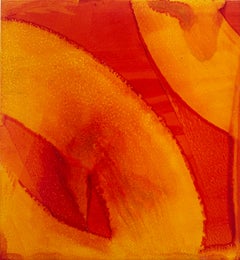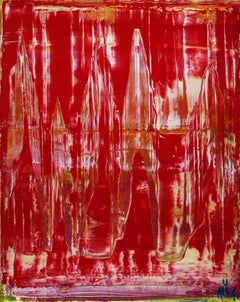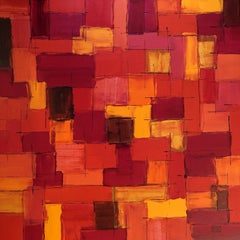Items Similar to Abstract Red Persimmon Oil Painting on Panel Marylyn Dintenfass Modernist
Want more images or videos?
Request additional images or videos from the seller
1 of 12
Marylyn DintenfassAbstract Red Persimmon Oil Painting on Panel Marylyn Dintenfass Modernist2004
2004
$4,500
£3,435.12
€3,948.90
CA$6,332.30
A$7,041.79
CHF 3,698.50
MX$86,092.89
NOK 46,086.83
SEK 43,447.43
DKK 29,471.56
About the Item
Provenance: Babcock Galleries (bears their label verso. signed verso with artists monogram signature.
Marylyn Dintenfass (born 1943) is an American painter, printmaker, and sculptor. She is primarily known for her oil paintings, which use a dynamic color palette and lexicon of gestural imagery to explore dualities in the human experience and everyday sensual pleasures.
Marylyn Dintenfass was born in 1943 in Brooklyn, New York and spent most of her early years in Brooklyn and then Long Island. She attended Queens College, and graduated in 1965 with a bachelor's degree in Fine Arts. During this time, the artist worked with Abstract Expressionist painter John Ferren and muralist Barse Miller. Marilyn Dintenfass explored new media and developed her own reaction to abstract expressionism with color, line, and gesture. Dintenfass acquired an appreciation for a broad range of materials that led to major sculpture installations composed of ceramic materials, steel, lead, wood, wax and a variety of pigments and epoxies.
Following a tour of museums in Amsterdam, Paris and Rome, the artist made her way to Jerusalem in 1966. During this journey, the artist worked with painter Ruth Bamberger, studied etching and mingled with the artists and intellectuals of the city. The result was Dintenfass's first architectural commission, to design the “Pop Op Disco,” Jerusalem's first disco. This commission allowed her to work with an array of materials to employ shapes, surfaces, textures, colors, and lights, all of which coalesced in her consciousness that would become important components of her mature personal visual vocabulary. Dintenfass also married and started her family during these years.
Art critic Meredith Mendelsohn writes, “Dintenfass uses luscious colors, repetitive forms, and a gestural intensity that combines Abstract Expressionism and Pop Art.”
Dintenfass often works with oil paint on wooden panels fragmented into parts of a grid. "After completing a painting," writes curator and critic Lilly Wei in a study of Dintenfass' work, "Dintenfass literally takes it apart, treating each panel as a discrete entity, exchanging panels between works in an aesthetic mix and match as she searches for interactions and relationships of color and form that satisfy her sense of visual excitement, sparked by the frisson of the dissonant." In an interview with critic Irving Sandler, Dintenfass speaks of the grid as a necessary, formal restraint for the passion of the gestural marks it contains. Joyce Robinson illuminates; “Dintenfass is at heart, though, a painter, and the grid, with its reference to and notion of modular parts, has remained central to her artistic enterprise, functioning as a kind of Apollonian matrix holding in check the exuberant, vividly colored abstractions of this essentially Dionysian artist.”
Lilly Wei adds, "Ultimately, however, Dintenfass is more sensualist than theorist, and her paintings owe much of their allure to their materiality and the dazzle of color. Her array of ripe, radiant, saturated hues—a palette of gorgeous diversity—can be silkily smooth and nuanced; boldly exuberant; or edgily, feverishly discordant."
The artist's abstract imagery usually appears in her work as various forms of stripes or circles arranged across translucent layers of alternating matte and high gloss textures. In a conversation with gallery owner, John Driscoll, Dintenfass likens these symbols to language that predates the written word, saying her "work relates to communication through the visceral channel." Rooted in autobiography, the artist's paintings also examine the contrast between what she calls the “micro” and the “macro.” At times the shapes simultaneously resemble cells under a microscope and visions of the cosmos. Dintenfass' themes explore the dualities of everyday pleasures; depending on the focus of a series, her symbols might conjure characters, candies, car wheels, or paint itself.
Although known for her paintings, Dintenfass was first recognized for her sculptural installations. Her innovative use of mixed media (ceramics, epoxies, wax, pigments, steel, lead, wood, etc.) transformed understanding of what a “ceramic” work of art could be and firmly fixed her position and influence among a generation of mixed media artists expanding the traditional definitions and boundaries of object and materials to create modern art. The results came as architectural reliefs and installation sculpture unique to her organic but structural personal style. Similar to her paintings, Dintenfass developed a modular language of symbols, amalgams of line and curve, which she would combine to create detailed pictographic languages all her own, what she has called “organic alphabets.” As Ted Castle relates, “Ideas are furtive elements, stolen from the matrix, so as to be reformed by human genius into something unforeseen—a poem, a painting, a game of dominoes, a television set, a brick, a tile, a cup. Marylyn Dintenfass is a master of the transformation of ideas into palpable form.”
Dintenfass has also been commissioned to create many large-scale installations, including works for the State of Connecticut Superior Courthouse; the Port Authority of NY 42nd Street Bus Terminal; IBM in Atlanta, Charlotte, and San Jose; The Baltimore Federal Financial Building; Ben Gurion University, Israel; Tagimi Middle School, Japan; and her 2010 project (and largest project to date) in Ft Myers, Florida entitled “Parallel Park.”
"Parallel Park" is a site-specific artwork for the exterior walls of the Lee County Justice Center's Parking Garage encompassing 30,000 square feet (2,800 m2). Dintenfass's images were enlarged to 10 times their original size employing specialized digitizing software resulting in 23 images, each 33 feet (10 m) high x 23 feet (7.0 m) wide and commercially printed with archival ink on Kevlar fabric and installed on all four facades of the parking structure. Each panel transforms the perimeter of the structure, creating a progression of changing images and colorful patterns, all of which are key elements represented in Dintenfass's paintings and drawings. These images and patterns recall architectural friezes, mosaics, and frescoes of the ancient, medieval and Renaissance artists as well as works by early modern artists such as the Synchromists and the Italian Futurists.
Dintenfass’ work has been included in more than 60 national and international exhibitions and more than a dozen solo shows including the Queens Museum of Art the Katonah Museum, The Greenville County Museum of Art and, at the Mississippi Museum of Art –an exhibition underwritten by the Andy Warhol Foundation. In 2008, her work was included in the inaugural exhibition of the Museum of Arts and Design in New York.
More than 30 public collections hold works by Dintenfass, including the Museum of Fine Arts Houston, Minneapolis Institute of Arts, the Cleveland Museum, The Detroit Institute of Arts, the Smithsonian American Art Museum, and the Metropolitan Museum of Art in New York City.
Dintenfass has twice been a MacDowell Fellow, was awarded a New York Foundation for the Arts Individual Artists Grant, and two National Endowment Project Grants. She was awarded the Silver Medal at the First International Exhibition, Mino, Japan, and the Ravenna Prize at the 45th Concorso Internazionale Della Ceramica D’Arte, Faenza, Italy. She was also a member of the faculty at Parsons School of Design in New York City for ten years. She is included in the recent book 100 New York Painters by Cynthia Maris Dantzig (Schiffer, 2006) and is the subject of Lilly Wei's recently published monograph Marylyn Dintenfass Paintings from Hudson Hills Press.
This artist has earned many honors in the art world. In 1983, Dintenfass garnered the Outstanding Achievement Award, Women in Design International Exhibition in San Francisco, CA. In Mino, Japan she was given the 1986 Silver Medal in the First International Exhibition. More recently in 2002-2003, she became a trustee at the Museum of Ceramic Art in New York City. In addition to these honor, Dintenfass has been a MacDowell fellow and a New York Foundation for the Arts Individual Artist Fellow. The National Endowment for the Arts also gave her two project grants. Dintenfass has also become involved in academia. She was a visiting professor at the National College of Art and Design in Norway, Bezalel Academy of Art and Design in Israel, Sheridan College in Canada, as well as Hunter College in New York city. Additionally, Dintenfass held a faculty position at Parsons School of Design (New York City) where she worked for 10 years.
- Creator:Marylyn Dintenfass (1943, American)
- Creation Year:2004
- Dimensions:Height: 12 in (30.48 cm)Width: 12 in (30.48 cm)Depth: 2 in (5.08 cm)
- Medium:
- Movement & Style:
- Period:
- Condition:good. minor wear.
- Gallery Location:Surfside, FL
- Reference Number:1stDibs: LU38215596272
About the Seller
4.9
Platinum Seller
Premium sellers with a 4.7+ rating and 24-hour response times
Established in 1995
1stDibs seller since 2014
1,800 sales on 1stDibs
Typical response time: <1 hour
- ShippingRetrieving quote...Shipping from: Surfside, FL
- Return Policy
Authenticity Guarantee
In the unlikely event there’s an issue with an item’s authenticity, contact us within 1 year for a full refund. DetailsMoney-Back Guarantee
If your item is not as described, is damaged in transit, or does not arrive, contact us within 7 days for a full refund. Details24-Hour Cancellation
You have a 24-hour grace period in which to reconsider your purchase, with no questions asked.Vetted Professional Sellers
Our world-class sellers must adhere to strict standards for service and quality, maintaining the integrity of our listings.Price-Match Guarantee
If you find that a seller listed the same item for a lower price elsewhere, we’ll match it.Trusted Global Delivery
Our best-in-class carrier network provides specialized shipping options worldwide, including custom delivery.More From This Seller
View All"AKEE" Oil Painting, Marylyn Dintenfass Modernist Abstract Expressionist Pop Art
By Marylyn Dintenfass
Located in Surfside, FL
Provenance: Babcock Galleries (bears their label verso.) signed verso with artists monogram signature.
Marylyn Dintenfass (born 1943) is an American painter, printmaker, and sculptor. She is primarily known for her oil paintings, which use a dynamic color palette and lexicon of gestural imagery to explore dualities in the human experience and everyday sensual pleasures.
Marylyn Dintenfass was born in 1943 in Brooklyn, New York and spent most of her early years in Brooklyn and then Long Island. She attended Queens College, and graduated in 1965 with a bachelor's degree in Fine Arts. During this time, the artist worked with Abstract Expressionist painter John Ferren and muralist Barse Miller. Marilyn Dintenfass explored new media and developed her own reaction to abstract expressionism with color, line, and gesture. Dintenfass acquired an appreciation for a broad range of materials that led to major sculpture installations composed of ceramic materials, steel, lead, wood, wax and a variety of pigments and epoxies.
Following a tour of museums in Amsterdam, Paris and Rome, the artist made her way to Jerusalem in 1966. During this journey, the artist worked with painter Ruth Bamberger, studied etching and mingled with the artists and intellectuals of the city. The result was Dintenfass's first architectural commission, to design the “Pop Op Disco,” Jerusalem's first disco. This commission allowed her to work with an array of materials to employ shapes, surfaces, textures, colors, and lights, all of which coalesced in her consciousness that would become important components of her mature personal visual vocabulary. Dintenfass also married and started her family during these years.
Art critic Meredith Mendelsohn writes, “Dintenfass uses luscious colors, repetitive forms, and a gestural intensity that combines Abstract Expressionism and Pop Art.”
Dintenfass often works with oil paint on wooden panels fragmented into parts of a grid. "After completing a painting," writes curator and critic Lilly Wei in a study of Dintenfass' work, "Dintenfass literally takes it apart, treating each panel as a discrete entity, exchanging panels between works in an aesthetic mix and match as she searches for interactions and relationships of color and form that satisfy her sense of visual excitement, sparked by the frisson of the dissonant." In an interview with critic Irving Sandler, Dintenfass speaks of the grid as a necessary, formal restraint for the passion of the gestural marks it contains. Joyce Robinson illuminates; “Dintenfass is at heart, though, a painter, and the grid, with its reference to and notion of modular parts, has remained central to her artistic enterprise, functioning as a kind of Apollonian matrix holding in check the exuberant, vividly colored abstractions of this essentially Dionysian artist.”
Lilly Wei adds, "Ultimately, however, Dintenfass is more sensualist than theorist, and her paintings owe much of their allure to their materiality and the dazzle of color. Her array of ripe, radiant, saturated hues—a palette of gorgeous diversity—can be silkily smooth and nuanced; boldly exuberant; or edgily, feverishly discordant."
The artist's abstract imagery usually appears in her work as various forms of stripes or circles arranged across translucent layers of alternating matte and high gloss textures. In a conversation with gallery owner, John Driscoll, Dintenfass likens these symbols to language that predates the written word, saying her "work relates to communication through the visceral channel." Rooted in autobiography, the artist's paintings also examine the contrast between what she calls the “micro” and the “macro.” At times the shapes simultaneously resemble cells under a microscope and visions of the cosmos. Dintenfass' themes explore the dualities of everyday pleasures; depending on the focus of a series, her symbols might conjure characters, candies, car wheels, or paint itself.
Although known for her paintings, Dintenfass was first recognized for her sculptural installations. Her innovative use of mixed media (ceramics, epoxies, wax, pigments, steel, lead, wood, etc.) transformed understanding of what a “ceramic” work of art could be and firmly fixed her position and influence among a generation of mixed media artists expanding the traditional definitions and boundaries of object and materials to create modern art. The results came as architectural reliefs and installation sculpture unique to her organic but structural personal style. Similar to her paintings, Dintenfass developed a modular language of symbols, amalgams of line and curve, which she would combine to create detailed pictographic languages all her own, what she has called “organic alphabets.” As Ted Castle relates, “Ideas are furtive elements, stolen from the matrix, so as to be reformed by human genius into something unforeseen—a poem, a painting, a game of dominoes, a television set, a brick, a tile, a cup. Marylyn Dintenfass is a master of the transformation of ideas into palpable form.”
Dintenfass has also been commissioned to create many large-scale installations, including works for the State of Connecticut Superior Courthouse; the Port Authority of NY 42nd Street Bus Terminal; IBM in Atlanta, Charlotte, and San Jose; The Baltimore Federal...
Category
Early 2000s Abstract Abstract Paintings
Materials
Oil, Panel
Large Oil Painting Color field, Minimalist, Abstract Expressionist John Zinsser
By John Zinsser
Located in Surfside, FL
John Zinsser
(American, b. 1961)
Iron City, 1997
oil on canvas
signed John Zinsser, titled and dated (verso)
72 x 60 inches
Done in bright vibrant shades of red.
American artist John Zinsser was born in New York City in 1961 and studied art, art history and literature at Yale University (where he did his senior thesis on Andy Warhol). He co-founded Journal of Contemporary Art in 1987 and lectures at The New School. He has had over 40 solo shows in the U.S. and Europe, and is known in Europe for his association with monochrome painters of a previous generation. Zinsser has been a devotee of postwar Abstract Expressionism and Minimalism for decades.
A native New Yorker, he came of age as an artist during the late 1980s and early 1990s alongside other now established abstract painters, including Richmond Burton, Gail Fitzgerald, Daniel Levine, Carl Ostendarp, Kate Shepherd, Cary Smith, Dan Walsh, Mary...
Category
1990s Abstract Expressionist Abstract Paintings
Materials
Canvas, Oil
Joan Kahn Rome Vibrant Bold Color Abstract Expressionist Modernist Oil Painting
Located in Surfside, FL
Oil paint on heavy tar paper.
Hand signed and dated verso.
Joan Kahn (USA 1953-) grew up in New York City; Princeton, New Jersey; and Vermont; in an environment that patronized the arts. At home her father, a professor, and mother, a state economist and homemaker, collected nineteenth and twentieth century drawings and prints, Middle eastern rugs, and ceramics, pewter, and old tools. Her grandfather, Max Westfield, was an academically trained portrait painter and her great uncle was a well-known gallery owner and art dealer in pre-World War II Germany. One of the influential experiences of Joan’s youth was visiting her grandfather in his studio in Tennessee where the family had first immigrated.
Growing up near New York, and spending a year in Paris during high school, provided formative visits to museums and galleries. Joan was academically talented in grade and high school, but after her father’s death during her first years at university she found herself concentrating on studio and history of art. It was a subject above others absorbed and concentrated her focus.
Influential in Joan’s development and later work are the historic movements of the Bauhaus and Modernist design and architecture, geometric art and design of diverse cultures, Color Field Painting. Many artists have had a impact on her work, such as Paul Klee, Piet Mondrian, Sonia Delaunay, Mark Rothko, Ad Reinhardt, Antoni Tapies, David Smith, John McLaughlin, Tony Smith, Louise Nevelson, Robert Mangold, Ellsworth Kelly, Agnes Martin, Valerie Jaudon, Jasper Johns, James Turrell, Robert Irwin, Vija Celmins, Caio Fonseca, Peter Halley, Ed Moses, Juan Usle, and Nancy Haynes...
Category
1980s Abstract Expressionist Abstract Paintings
Materials
Oil
Joan Kahn Rome Vibrant Bold Color Abstract Expressionist Modernist Oil Painting
Located in Surfside, FL
Oil paint on heavy tar paper.
Hand signed and dated verso.
Joan Kahn (USA 1953-) grew up in New York City; Princeton, New Jersey; and Vermont; in an environment that patronized the arts. At home her father, a professor, and mother, a state economist and homemaker, collected nineteenth and twentieth century drawings and prints, Middle eastern rugs, and ceramics, pewter, and old tools. Her grandfather, Max Westfield, was an academically trained portrait painter and her great uncle was a well-known gallery owner and art dealer in pre-World War II Germany. One of the influential experiences of Joan’s youth was visiting her grandfather in his studio in Tennessee where the family had first immigrated.
Growing up near New York, and spending a year in Paris during high school, provided formative visits to museums and galleries. Joan was academically talented in grade and high school, but after her father’s death during her first years at university she found herself concentrating on studio and history of art. It was a subject above others absorbed and concentrated her focus.
Influential in Joan’s development and later work are the historic movements of the Bauhaus and Modernist design and architecture, geometric art and design of diverse cultures, Color Field Painting. Many artists have had a impact on her work, such as Paul Klee, Piet Mondrian, Sonia Delaunay, Mark Rothko, Ad Reinhardt, Antoni Tapies, David Smith, John McLaughlin, Tony Smith, Louise Nevelson, Robert Mangold, Ellsworth Kelly, Agnes Martin, Valerie Jaudon, Jasper Johns, James Turrell, Robert Irwin, Vija Celmins, Caio Fonseca, Peter Halley, Ed Moses, Juan Usle, and Nancy Haynes...
Category
1980s Abstract Expressionist Abstract Paintings
Materials
Oil
Large Painting "Red Sky" Oil & Spackle on Wood Katherine Bowling American Modern
By Katherine Bowling
Located in Surfside, FL
Katherine Bowling (American, b. 1955)
Oil on spackle on wood
1988
Hand signed, titled and dated verso,
Dimensions: 48"h x 48"w
Provenance: From an Important Private Collection, NYC; bears gallery label from Blum Helman Gallery, NYC
Notes/Literature: Exhibited: "Earth and Sky: Recent Paintings by Katherine Bowling, Joan Nelson and Ellen Phelan", Hood Museum of Art, Dartmouth College 1992
Katherine Bowling (born 1955, Washington, D.C.) is a modernist painter known for her layered landscape paintings that draw inspiration from nature in the Hudson Valley.
Katherine Bowling grew up in Tidewater, Virginia. She received her BFA from Virginia Commonwealth University in 1978.
Bowling's first New York show, as well as her first solo exhibition, was in 1987.
Bowling's works tend to be luminous landscape paintings that often feature woods and fields as well as roads. Many of her paintings are based on her photographs of woods and fields surrounding and in Schoharie County, where she rents a house. As Molly O'Neill notes in an essay on Bowling and her work, this area is "fifty miles northwest of the vistas that inspired the Hudson River School painters in the mid-1800s."
Bowling focused in particular on the imagery of roads for the theme of her exhibition at Greenberg Van Doren, Divide. As the title implies, writes Lilly Wei in the exhibition's accompanying catalog, Bowling views the roads as "abstract marks in the landscape that divide and order space." Even with roads she has often traveled, Bowling finds something new on closer inspection that alters her perception of the familiar and mundane. Bowling explains that the roads "function as a metaphor for memory and displacement."
In 2001, Bowling exhibited a number of seascape paintings. In her essay on the exhibition, art historian and critic Nancy Princenthal writes that, far from being an aberration from Bowling's typically home-based scenes, the ocean paintings are "a return to childhood memories and life long inclinations. A native of Virginia, she spent her first summers at the Atlantic shore and on the Chesapeake Bay."
Primarily, however, Bowling's works focus on capturing the play of light and shadow. Art critic Eleanor Heartney notes that "Her paintings, like those of Monet, Pissarro, and Renoir, focus on the ephemeral moment and the fleeting impression, conjuring the flicker of sunlight through the trees, the shifting shadows of early evening, the reflections of clouds and foliage glancing across the rippling surface of a lake."
They have a luminist quality to them.
O'Neill argues that Bowling additionally "has an innate sense of abstraction and she ranges happy as an uncaged chicken, pecking elements from the Impressionists' obsession with light; from modern photography; and the drip paintings of Jackson Pollock."
Bowling is influenced by the use of light in the paintings of European Romantics such as J. M. W. Turner and John Constable as well as by the later work of George Inness: Her paintings also recall landscapes by Claude Lorraine, Albert Pinkham Ryder and Camille Corot.
Bowling is known for her use of spackle. She uses a long process of layering and sanding to create the "back-lit" effect found in her paintings.
First, the paintings begin as a photograph which she typically takes near her rented house in the Hudson Valley. Then, she uses these photographs, which serve as her "preliminary drawings," to aid in the painting process. She also paints from memory and direct observation. Bowling paints on square panels of plywood. Bowling considers rectangular pieces to be too horizontal and rife of implications already of landscapes and horizons. She sometimes paints on one of these square and sometimes paints on several square panels together. The seams between these adjoined panels are left visible. Next, Bowling applies layers of spackle. O'Neill remarks that "Inspired, perhaps, by her day job of painting houses, [Bowling] turned to more industrial media: damp vinyl spackle, a building compound that is applied to wooden panels to create a matte, fresco-like surface. Thinned oil pigments are poured, allowed to dry, and then the Sisyphean task of sanding begins." Initial layers generally correspond with the color of the light—varying from pinks, golds, blues, and oranges. Through this layering and sanding, she creates a luminous quality in her landscapes.
Despite rigorous sanding, air bubbles within the spackle layers are revealed occasionally on the surface. Rather than disguise them, Bowling integrates them. Heartney writes that Bowling "allows these irregularities to become part of the painting so that the viewer's perception of the play of light and shadow across the image cannot be separated from an awareness of surface itself."
In later stages of painting, Bowling stands above panels to throw, dribble, and splatter paint with a hair dryer, recalling the techniques of Abstract Expressionist artists such as Jackson Pollock.
Awards and honors
1991 National Endowment for the Arts Grant
1989 New York State Foundation for the Arts Fellowship
1988 Mid Atlantic Arts Foundation Fellowship
Notable public collections
The Metropolitan Museum of Art, New York, NY
Brooklyn Museum of Art, New York, NY
Mary and Leigh Block Museum of Art, Evanston, IL
Phoenix Art Museum, Phoenix, AZ
Norton Museum of Art, West Palm Beach, CA
Fisher Landau Center, New York, NY
Select exhibitions
2025 PS122 Gallery Lower East Side, New York
2022 Katherine Bowling: Trees Winston Wachter Fine Art, New York
2013 Woods, Lovely Dark and Deep. DC Moore Gallery Chelsea NY
Featuring: Eric Aho, Milton Avery, Romare Bearden, Dozier Bell, Jake Berthot, Katherine Bowling, Charles Burchfield, Mary Frank, Noriko Furunishi, April Gornik, Marsden Hartley, Daniel Heidkamp, David Hilliard, Mark Innerst, Max Jansons, Sissel Kardel, Whitfield...
Category
1980s Abstract Paintings
Materials
Plaster, Wood, Oil
Abstract Expressionist Color Field Painting Indian Artist Sangeeta Reddy
Located in Surfside, FL
Born in 1955, Hyderabad, India, painter and writer Sangeeta Reddy migrated to the United States in 1978 and continued her studies in art. Currently she maintains a studio on Santa Fe Dr. in Denver, Colorado and Hyderabad, India, dividing her time between the two. She has been represented by various galleries in Aspen, Denver, New York, New Delhi, Chennai and now, Hyderabad since the beginning of her 26 year career.
Sangeeta has lived and breathed the arts from a very young age – her maternal grandmother was a contemporary of the classical vocalist Kesarbai Kerkar, her grandfather a connoisseur of the arts. Steeped in music, her mother was one of the first disciples of the late Pandit Ravi Shankar. Her late father was a pictorial photographer who co-founded the Hyderabad Photographic Society. Sangeeta chose to follow her own path into the visual and literary arts.
With seven years of undergraduate work in fine art in India and the US, and a bachelor’s from Bombay University in English literature and Philosophy, in 1985, Sangeeta’s work has developed into a highly individual style of mixed media abstract expressionistic paintings and monotypes on both canvas and paper. The deconstructed calligraphy and vibrant and nuanced color ever present in her work gives the work the flavor of India in concert with a western restraint.
Known primarily for her mixed media collages on paper and canvas, her abstract work was conceived from a challenge to visually parallel Sankara’s idea of Brahman in Advait philosophy and has now evolved into a formal language of deconstructed Devanagari calligraphy. Her artistic influences range widely from Indian weaving and textiles to Vincent Van Gogh, Paul Cezanne and Pablo Picasso (who were introduced to her at a very young age by her father’s interest in Western art), to her discovery (while studying in the US) of the Taos School of landscape painters as well as the Abstract expressionist painters, painters, in particular, Mark Rothko and Willem De Kooning, Robert Motherwell, Antoni Tapies and Richard Diebenkorn.
After having worked for 28 years in an abstract expressionist manner, her latest series of paintings are based on the rock formations of the Colorado Plateau. She was first Inspired By Abstract Expressionists like Barnett Newman, Mark Rothko, Clyfford Still, Ray Parker, her style evolved into abstract expressionism and color field painting, Since moving to the US she has become familiar with some of the artistic giants – Georgia O’keeffe, Maynard Dixon, Ernest Blumenschein, Victor Higgins and John Marin, much later of the Group of Seven and of Regionalism. The mountains and plains, canyons and stretches of sky, pinion, sage and cottonwoods. Mostly they were in the form of small plein air works in pastel, charcoal or water color, or drawings from memory or photographs that were more reductive and expressionistic. She has also worked in monotype techniques and in collage.
SELECTED EXHIBITIONS
Recent Shows:
2016 Fractured Landscapes of the West, BMOCA, Boulder, CO
2014 Erasing Borders 11th Annual Exhibition of Contemporary Indian Art, Queens Museum, NYC
2014 LA Artcore, Los Angeles
2013 Shrishti Art Gallery, Hyderabad, India
2013 Erasing Borders 10th Annual Exhibition of Contemporary Indian Art, 2012 Erasing Borders 9th Annual Exhibition of Contemporary Indian Art, Art Crossings, Queens, the Bronx school for the Arts, New York and Art6, Richmond, Virginia.
2011 “IAAC Erasing Borders: 8th Annual Exhibition of Contemporary Indian Art”, Queens Museum of Art, Queens, New York, Aicon Gallery, NYC, Charles B. Wang Center, Stony Brook and Jorgenson Center,
2011 The William Havu gallery, Denver, Colorado
2009 15th Street Gallery, Boulder
2009 Retrospective, Rocky Mountain Women...
Category
1980s Abstract Expressionist Abstract Paintings
Materials
Paper, Paint, Mixed Media
You May Also Like
Vibrant, Abstract, Gestural Painting 'Nougat' by Marylyn Dintenfass
By Marylyn Dintenfass
Located in White Plains, NY
Available at Madelyn Jordon Fine Art. 'Nougat' by Marylyn Dintenfass, 2009. Oil on panel, 12 x 12 in. This abstract painting features a vibrant palette of red and orange. Through a d...
Category
Early 2000s Abstract Abstract Paintings
Materials
Oil, Panel
Dimensional Red, Painting, Acrylic on Canvas
By Nestor Toro
Located in Yardley, PA
Fiery abstract painting mainly red with dents and gold/copper tones. Ready to hang and signed in front. I include a certificate of authenticity that lists the materials as well as...
Category
2010s Abstract Abstract Paintings
Materials
Acrylic
Abstract with Red Forms, Large Painting by Dan Teis
By Dan Teis
Located in Long Island City, NY
Artist: Dan Teis
Title: Abstract with Red Forms
Year: 1980
Medium: Acrylic on Canvas, Signed l.r.
Size: 54 x 60 in. (137.16 x 152.4 cm)
Frame Size: 55.5 x 61.75 inches
Category
1980s Abstract Abstract Paintings
Materials
Canvas, Acrylic
Spektrum Series Rouge, Painting, Acrylic on Canvas
By Lianna Klassen
Located in Yardley, PA
The Spektrum Series is based on the hope and joy I find in coming into this new year with all it's potential. My hope is to create an atmosphere through this series where the observ...
Category
2010s Abstract Abstract Paintings
Materials
Acrylic
Deep Red - Acrylic by Anna Maria Caboni - 2022
By Anna Maria Caboni
Located in Roma, IT
This acrylic painting Deep Red was realized in 2022 by the Italian artist Anna Maria Caboni.
Hand-signed and dated by the artist on the lower right. Perfect conditions.
This fascin...
Category
2010s Contemporary Abstract Paintings
Materials
Acrylic
Red II, Abstract Oil Painting on Canvas by Gustavo Schmidt
By Gustavo Schmidt
Located in Long Island City, NY
Artist: Gustavo Schmidt
Title: Red II
Year: 2016
Medium: Oil on Canvas, signed and titled verso
Size: 54 x 44 inches
Category
2010s Abstract Expressionist Abstract Paintings
Materials
Canvas, Oil
More Ways To Browse
Four Panel Painting
Japanese Painting On Wood Panel
Set Of Four Oil Paintings
Italian Ceramics Abstract
Large Italian Wood Panels
Abstract Japanese Ceramics
Medieval Panel
Ben Long
Irving Oil
Ancient Brick
Frieze Drawing
Persimmon Art
Oil Paintings Mississippi
Fresco Panel
Abstract Ceramic Tile
Brick Building Painting
Joyce Oil
Japanese Tile
